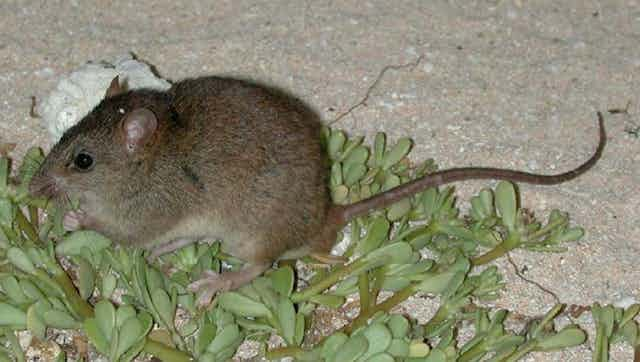The Bramble Cay Melomys (Melomys rubicola) has one of the most unusual and precarious distributions of all Australian mammals. The melomys is restricted to an unstable 4-5 hectare coral cay in the eastern Torres Strait, off the tip of northern Australia.
This little known rodent, related to rats and mice, is morphologically and genetically distinct from Australian and known New Guinean species.
It is nocturnal and shelters in burrows or under debris where there’s vegetation. It is likely vegetarian, as the melomys have frequently been observed feeding on the fleshy herbs found on the cay.
Just how the species became isolated on such a remote coral cay remains a mystery. Given its close relatedness to Australian melomys, it’s been suggested it is a result of stranding by rising sea levels as ice melted following the Last Glacial Maximum.
Alternately, it could have come from an unknown population somewhere in the Fly River region of southern New Guinea. Bramble Cay is located only 50km from the mouth of the river, and logs and debris are regularly flushed out and deposited on the shoreline of the cay. We don’t have many records of mammals from the Fly River, so it remains a distinct possibility that the Bramble Cay Melomys or a closely related species could be found there.

Status
There are accounts of visits to Bramble Cay in the mid 1800s that describe the Bramble Cay Melomys as abundant.
In 1998, 42 individuals were captured in live traps over six nights. The population was estimated to be around 98 individuals.
Repeat surveys in 2002 and 2004 recorded 10 and 12 individuals respectively, and annual visits to the cay by turtle researchers since 2007 have failed to detect any presence of the species at all. The small, apparently declining population and limited distribution place the Bramble Cay Melomys at high risk of extinction.
Threats
The small population size means genetic drift, disease and introduced species all pose a threat to the species.
Habitat loss via erosion of the cay is the single most important threat, particularly given that sea levels are predicted to rise thanks to climate change. Bramble Cay is by no means stable. Between 1958 and 1987, the cay decreased in size; but in 2011 it had returned to a size comparable to 1958.
While the size of the cay varies, the vegetation on it is shrinking, and this might be the main cause of the melomys’ decline.
Bramble Cay also serves as a rookery to marine turtles and seabirds. The vegetation is disturbed by nesting seabirds throughout the year and by turtles between October and March. In our December 2011 survey the area disturbed by turtles was quite extensive, and many turtles were nesting towards the centre of the cay. Photos show a substantial reduction in the cover of vegetation between 2009 and 2011.

Strategy
The priority for the Bramble Cay Melomys is monitoring and establishing insurance populations on other islands or in captivity. Clearly, the most immediate action required is to confirm if the population still occurs on Bramble Cay, as it has not been seen since 2004.
Also, we need to find out if the melomys is found outside the cay. Larger islands that lie near Bramble Cay are instead inhabited by a different species, the Grassland Melomys (Melomys burtoni). But there are myriad smaller islands and cays in the Torres Strait that have never been surveyed. We should also be looking in the Fly River region of New Guinea.
Conclusion
Some may argue that the extinction of a species of mammal restricted to unstable small coral cay is not a great loss. But the Bramble Cay Melomys is a unique and intriguing component of Australia’s mammalian fauna. Its loss would add to Australia’s already embarrassing mammal extinction records and the impending extinction crisis of northern Australian mammalian species.

The Conversation is running a series on Australian endangered species. See it here


